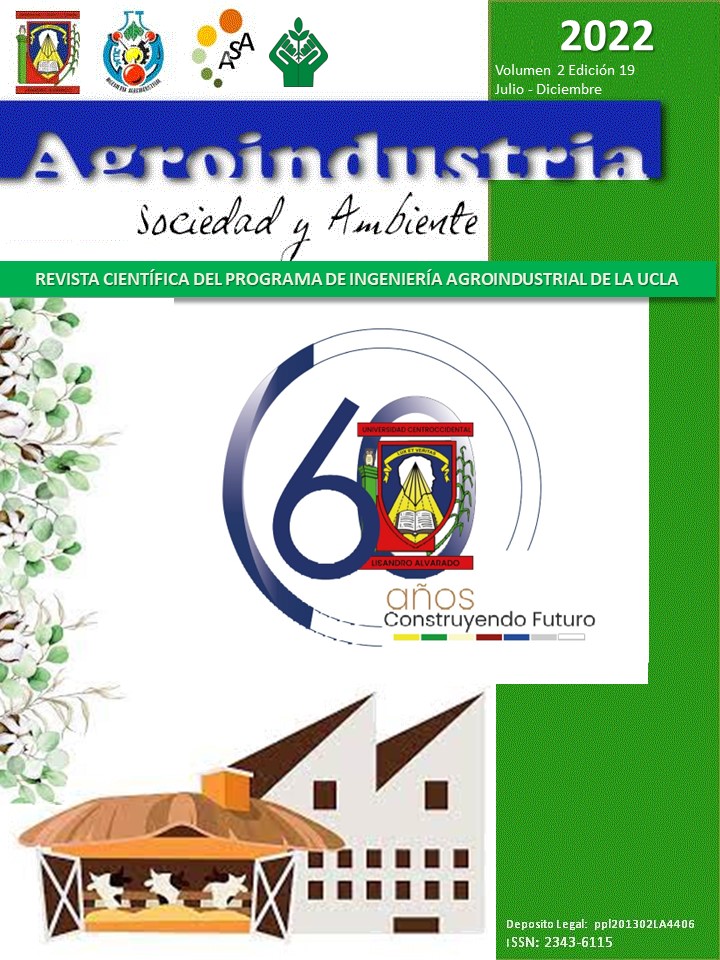Modeling Mechanical Vibrations Using Matlab's Graphical User Interfacer
DOI:
https://doi.org/10.5281/zenodo.7365361Keywords:
Efficiency, industrial engineering, industrial machineryAbstract
Quality management is all the processes that are carried out in a company to ensure optimal execution of its activities, including the maintenance of machinery. Mechanical vibrations play a very important role in all physical phenomena in which a body vibrates and therefore suffers changes around a point of equilibrium, even affecting the operation of machinery involved in industrial processes, therefore the modeling of vibrations will establish control and measurement mechanisms for preventive maintenance, from the estimation of the current and future state of the instruments. For the modelling of the vibrations in industrial processes, second order differential equations with constant coefficients have been used through the Runge-Kutta method. To facilitate the resolution of the equation system, a Graphical User Interface has been developed using the MATLAB program, which allows the modelling of the general problem of mechanical vibrations, Therefore, the objective of this research was to evaluate the use of a graphic user interface for the modeling of mechanical vibrations by solving second-order differential equations, using the Runge-Kutta method. The equation solving was applied to undamped vibrations, free damped vibrations, and forced vibrations, the applicability of the method was validated by an expert through the application of the Design Thinking tool, which allowed its validation through the application of a usability test. The results show that the developed Graphical User Interface is very useful for the identification, analysis and formulation of solutions on the problem of mechanical vibrations and preventive mechanical maintenance.
Downloads
References
Cheney, W., & Kincaid,D. (2011). Métodos numéricos y computación, Cengage.
Cornejo Serrano, M. D. C., Oliver, E. B. V., Reséndiz, S. M., & Galván, W. G. A. (2016). Sistema masa resorte con movimiento libre amortiguado, casos: sobreamortiguado, críticamente amortiguado y subamortiguado, su modelado y solución, con el apoyo de geogebra. Pistas Educativas, 38(121). http://www.itcelaya.edu.mx/ojs/index.php/pistas/article/viewFile/664/578
Costa, V., Torroba, P., & Devece, E. (2013). Articulación en la enseñanza en carreras de ingeniería: el movimiento armónico simple y las ecuaciones diferenciales de segundo orden lineal. Latin American Journal of Physics Education, 7(3), 350-356. http://www.lajpe.org/sep13/05-LAJPE_791_Viviana_Costa.pdf
de la Torre, E. F., Zacco, F., Guzzo, G., Harambillet, N., Dondo, D. G., Gelerstein, S., ... & Novillo, D. (2015). Movimiento amortiguado: Transición de sobreamortiguado a subamortiguado. Revista de Enseñanza de la Física, 27, 615-621.. https://revistas.unc.edu.ar/index.php/revistaEF/article/download/12713/12951
Escalante-Martínez, J. E., Laguna-Camacho, J. R., Gómez-Aguilar, J. F., Calderón-Ramón, C., Cruz-Orduña, M. I., Varguez-Fernández, R., & Anzelmetti-Zaragoza, J. C. (2016). Análisis del coeficiente de amortiguamiento viscoso en un sistema masa-resorte-amortiguador utilizando PPLANE y GEOGEBRA. Revista mexicana de física E, 62(2), 66-72.http://www.scielo.org.mx/scielo.php?script=sci_arttext&pid=S1870-35422016000200066
Espino-Roman, P., Davizon-Castillo, Y. A., Olaguez-Torres, J. E., Lizarraga-Lizarraga, A., Benitez-Garcia, I., & Nunez-Nalda, J. V. (2017). Didactic prototype for the teaching of mechanical vibrations through the design of a test bench for the imbalance and critical velocity. DYNA, 92(4), 395-398.
Funny, R. A. (2017). Using Matlab To Help Students Understanding Gauss-Jordan Methods. Angkasa, 9(2), 75-86.. https://pdfs.semanticscholar.org/ddf4/ef0d2c9d8630f4bfebc662105021dd131d92.pdf
González C., R. A. (2013). Métodos Numéricos y TIC´s en la solución de problemas de Vibraciones Mecánicas. In: XII Conferencia Internacional de ciencias de la educación, Camaguey, Cuba, Noviembre.
Guerrero, G. I., Bambill, D. V., & Felix, D. H. (2018). Efecto Poisson en las Vibraciones Libres de una Microviga por la Teoría del Gradiente. Mecánica Computacional, 36(6), 225-234.
Hu, J., Luo, Y., & Xu, J. (2019). Experimental and numerical analysis and prediction of ground vibrations due to heavy haul railway viaduct. Mathematical Problems in Engineering, 2019.. http://downloads.hindawi.com/journals/mpe/2019/2751815.pdf
Lázaro, M. (2015). Learning mechanical vibrations with Wolfram Mathematica. Modelling in Science Education and Learning, 8(2), 93-108.
López-Mariño, M. A., Hernández-Olvera, J. A., Barroso, L. A., & Trujillo Caballero, J. C. (2016). Cómputo simbólico y gráfico: estudio del sistema masa-resorte. Revista Brasileira de Ensino de Física, 39. http://www.scielo.br/scielo.php?pid=S1806-11172017000200402&script=sci_arttext&tlng=es
Matar, M., Parodi, M. A., Repetto, C. E., & Roatta, A. (2017). Modelización lineal de un sistema masa-resorte real. Revista Brasileira de Ensino de Física, 40.. https://doi.org/10.1590/1806-9126-rbef-2017-0238.
Omale, D., Ojih, P. B., & Ogwo, M. O. (2014). Mathematical analysis of stiff and non-stiff initial value problems of ordinary differential equation using MATLAB. International journal of scientific & engineering research, 5(9), 49-59.
Pallares Muñoz, M. R., & Rodríguez Calderon, W. (2009). Modeling of forced vibration phenomenon by making an electrical analogy with ANSYS finite element software. Ingenieria e Investigacion, 29(1), 5.. https://www.redalyc.org/pdf/643/64329102.pdf
Salokyová, Š., Krehel’, R., Pollak, M., & Kočiško, M. (2016). Research on impacts of mechanical vibrations on the production machine to its rate of change of technical state. Advances in mechanical engineering, 8(7), 1687814016655778.https://journals.sagepub.com/doi/pdf/10.1177/1687814016655778
Sarria, I., Cortés-Martínez, F., Garcia-Barruetabeña, J., & Mateos-Heis, M. (2015). Análisis de las vibraciones de sistemas de rigidez no lineal mediante el m cálculo fraccionario. DYNA-Ingeniería e Industria, 90(1).
Sauer, T., & Murrieta, J. E. M. (2013). Análisis numérico. Pearson Educación..
Sauro, J. (2011). Measuring usability with the system usability scale. http://www. measuringusability. com/sus. php and procedure (9.4. 2012.).
Tomasov Silva, I., & Rodríguez, C. G. (2018). Modelo para la estimación de una frecuencia natural a partir de la respuesta vibratoria de un sistema sometido a un barrido sinusoidal de alta aceleración. Ingeniare. Revista chilena de ingeniería, 26(1), 54-61.18. https://scielo.conicyt.cl/scielo.php?pid=S0718-33052018000100054&script=sci_arttext
Varanis, M., Silva, A. L., & Mereles, A. G. (2017). On mechanical vibration analysis of a multi degree of freedom system based on arduino and MEMS accelerometers. Revista Brasileira de Ensino de Física, 40. http://www.scielo.br/scielo.php?pid=S1806-11172018000100404&script=sci_arttext
Vega, A. M., & García, A. D. J. B. (2018). Diseño y fabricación de un sistema experimental para la medición de vibraciones mecánicas. Jóvenes en la ciencia, 4(1), 2527-2532..
Xing, M., Zhao, C., Wang, P., Lu, J., & Yi, Q. (2019). A numerical analysis of ground vibration induced by typical rail corrugation of underground subway. Shock and Vibration, 2019.. http://downloads.hindawi.com/journals/sv/2019/8406813.pdf
Published
How to Cite
Issue
Section
Copyright (c) 2022 Fredin Fernando Pozo Parra, Carlos Cuencas , Lizeth Fernanda Silva Godoy , Freddy Chipugsi

This work is licensed under a Creative Commons Attribution-NonCommercial-ShareAlike 4.0 International License.




